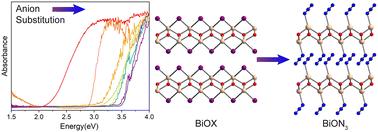氧化卤化铋中的阴离子交换用于BiON3的电子特性控制和分离
IF 6.4
1区 化学
Q1 CHEMISTRY, INORGANIC & NUCLEAR
引用次数: 0
摘要
氧化卤化铋是一类层状材料,通过阴离子取代具有丰富的化学和电子调谐潜力,包括较少探索的假卤化物,如叠氮化物(N3−)的掺入。在这里,我们开发了三种合成策略来合成BiON3:合成后交换、溶剂热合成和共沉淀。我们提出了由Rietveld细化支持的BiON3的第一个结构模型,揭示了层之间具有交叉叠氮分子的高度无序结构。然后,我们探讨了杂阴离子掺入对BiON3电子结构的影响,包括通过合成混合叠氮化物/碘化物体系。此外,我们证明了BiON3中有趣的热诱导反应性,这表明N原子转移和随后的气体演化。这项工作大大扩展了这种有前途的材料平台的合成控制的可用途径。本文章由计算机程序翻译,如有差异,请以英文原文为准。

Anion exchange in bismuth oxyhalides for electronic property control and isolation of BiON3
Bismuth oxyhalides are a class of layered materials with rich potential for chemical and electronic tuning through anionic substitution, including the less-explored incorporation of pseudohalides such as azide (N3−). Here, we develop three synthetic strategies for the synthesis of BiON3: post-synthetic exchange, solvothermal synthesis, and coprecipitation. We present the first structural model for BiON3 that is supported by Rietveld refinement, revealing a highly disordered structure that features interdigitated azide molecules between the layers. We then probe the effects of heteroanion incorporation on the electronic structure of BiON3, including through the synthesis of mixed azide/iodide systems. Further, we demonstrate intriguing thermally induced reactivity in BiON3 that is suggestive of N atom transfer and subsequent gas evolution. This work considerably expands the available routes for synthetic control of this promising material platform.
求助全文
通过发布文献求助,成功后即可免费获取论文全文。
去求助
来源期刊

Inorganic Chemistry Frontiers
CHEMISTRY, INORGANIC & NUCLEAR-
CiteScore
10.40
自引率
7.10%
发文量
587
审稿时长
1.2 months
期刊介绍:
The international, high quality journal for interdisciplinary research between inorganic chemistry and related subjects
 求助内容:
求助内容: 应助结果提醒方式:
应助结果提醒方式:


